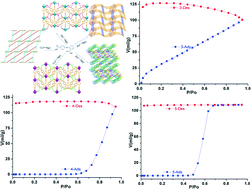Functionalities and architectures of coordination polymers with multi-dimensionalities via transition metal–dicarboxylate ligands†
Abstract
Five coordination polymers, namely, Zn(dpd)(bpy)0.5 (1), Zn(Hdpd)2(bpy)2·H2O (2), Co3(Hdpd)2(dpd)2(bpy)3(H2O)2·2H2O (3), Co(Hdpd)2(bpy)(H2O)2·2H2O (4) and Ni(Hdpd)2(bpy)(H2O)2·2H2O (5) (H2dpd = 2,4-diphenyl ether dicarboxylic acid, bpy = 4,4′-bipyridine) with zero-(0D), one-(1D), two-(2D) and three-dimensional (3D) structures have been synthesized under similar hydrothermal conditions using H2dpd, bpy and different transition metal salts. Compound 1 possesses a 3D framework with a {4·82}{4·82·103} topology. Compound 2 is a mononuclear structure which is further self-assembled through both hydrogen bonding and π⋯π stacking interactions to generate a 3D supramolecular structure. Compound 3 is made up of a 2D ladder network with {4·62}2{42·62·82} topology, which consists of 1D ladder-like chains. Compounds 4 and 5 are isostructural and feature 1D chains which are further connected by hydrogen bonding interactions to form 2D supramolecular structures. These compounds have been characterized using elemental analysis, infrared (IR), thermal gravimetric analysis (TGA), and single crystal X-ray diffraction. Furthermore, the fluorescence properties of 1–5 have been investigated. Water vapor sorption studies reveal that compounds 3, 4 and 5 exhibit very good water vapor uptakes (100.71 ml g−1 for 3, 109.94 ml g−1 for 4 and 108.96 ml g−1 for 5). Magnetic susceptibility measurements indicate that compounds 3 and 4 show antiferromagnetic interactions, while compound 5 shows ferromagnetic behavior.


 Please wait while we load your content...
Please wait while we load your content...